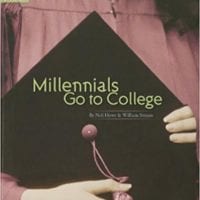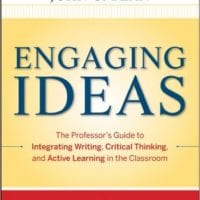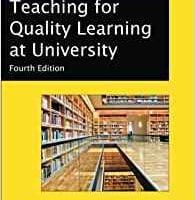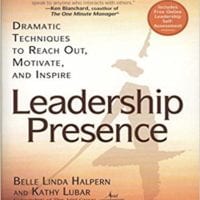From researching engaging teaching strategies and learning how to best work with millennials to discovering how to interact successfully with introverts, the CTE library provides answers. Faculty have access to information on what motivates learning, how to develop assessments and engagement techniques, as well as best practices from peers. These books, an instant source of valuable and actionable information, are available in Room F502, Haas School of Business.
Experiential Learning
Bruffee, K., (1999) Collaborative Learning (2nd Ed). Baltimore, MD: The John Hopkins University Press.
Csikszentmihalyi, M. (2008) Flow: The Psychology of Optimal Experience. New York, NY: Harper Perennial Modern Classics.
Christensen, C. (2010) Disrupting Class: How Disruptive Innovation Will Change the World Learns. San Francisco, CA: McGraw-Hill Education.
Heath, C., Heath, D. (2007) Made to Stick: Why Some Ideas Survive and Others Die. New York, NY: Random House.
Kolb, D.A., (1984) Experiential Learning: Experience as the Source of Learning and Development. Englewood Cliffs, NJ: Prentice Hall.
Koppett, K. (2012) Training to Imagine: Practical Improvisation Theatre Techniques for Trainers and Managers to Enhance Creativity, Teamwork, Leadership, and Learning. Sterling, VA: Stylus Publishing.
Kotler, S. (2014) The Rise of Superman: Decoding the Science of Ultimate Human Performance. Boston, MA: New Harvest.
Mack, G., Casstevens, D. (2002) Mind Gym: An Athlete’s Guide to Inner Excellence. San Francisco, CA: McGraw-Hill Education.
Robinson, K. (2011) Out of Our Minds: Learning to be Creative. Mankato, MN: Capstone.
Communication
Cialdini, R. (2006) Influence: The Psychology of Persuasion. New York, NY: Harper Business.
Finkelstein, J. (2011) Fuse: Making Sense of the New Cogenerational Workplaceâ„¢. Austin, TX: Greenleaf Book Group Press.
Halpern, B.L., and Lubar, K., (2003) Leadership Presence: Dramatic Techniques to Reach Out, Motivate and Inspire. New York, NY: Gotham Books.
Heinrichs, J. (2013) Thank You for Arguing: What Aristotle, Lincoln, and Homer Simpson and Teach Us About the Art of Persuasion. New York, NY: Three Rivers Press.
Laborde, G. (2012) Influence with Integrity. Palo Alto, CA: Syntony Publishing.
Lum, G. (2010) The Negotiation Fieldbook: Simple Strategies to Help You Negotiate Everything. San Francisco, CA: McGraw-Hill Education.
Malhorta, D., Bazerman, M. (2008) Negotiation Genius: How to Overcome Obstacles and Achieve Brilliant Results at the Bargaining Table and Beyond. New York, NY: Bantam.
Pease, A., Pease, B. (2006) The Definitive Book of Body Language. New York, NY: Bantam.
MBA Education
Khurana, R., (2007) From Higher Aims To Hired Hands: The Social Transformation of American Business Schools and the Unfulfilled Promise of Management as a Profession. Princeton, NJ: Princeton University Press.
Case Method
Andersen, E., Schiano, B., (2014) Teaching with Cases: A Practical Guide. Boston, MA: Harvard Business School Publishing. (5)
Barnes, L.B., Christensen, C.R., and Hansen, A., (1994) Teaching and the Case Method (3rd Ed). Boston, MA: Harvard Business School Press.
Bolton, M.A. Erskine, J.A., M.R. Leenders and L.A. Maufette-Leeders, (1981) Teaching with Cases. London, Canada: Research and Publications Division, School of Business Administration: The University of Western Ontario.
Bruner, R.F., (2003) Socrates’ Muse: Reflections on Effective Case Discussion Leadership. New York, NY: McGraw-Hill/Irwin.
Christensen, C., Garvin, D., and Sweet, A. (1991). Education for Judgment: The Artistry of Discussion Leadership. Boston, MA: Harvard Business School Press
Garvin, David A. “Teaching Executives and Teaching MBAs: Reflections on the Case Method.” Academy of Management Learning & Education 6, no. 3 (September 2007).
Heath, J. (2002) Teaching and Writing Case Studies (2nd Ed). Cranfield University, UK: The European Case Clearing House.
Lunberg, M.A., Levin, B.B., and Harrington, H.L., (1999) Who Learns What from Cases and How? Mahwah, NJ: LEA Publishers.
Lynn, L.E., (1999) Teaching and Learning with Cases: A Guidebook. New York, NY: Chatham House Publishers.
McNair, M.P., (1954) The Case Method at the Harvard Business School. New York, NY: McGraw-Hill.
Stake, R.E., (1995) The Art of Case Study Research. Thousand Oaks, CA: Sage Publications.
General Teaching
Ambrose, S., Bridges, M., DiPietro, M., Lovett, M., Norman, M., (2010) How Learning Works: 7 Research-Based Principles for Smart Teaching. San Francisco,CA: Jossey-Bass.
Arum, R., Roksa, J., (2011) Academically Adrift: Limited Learning on College Campuses. Chicago, IL: The University of Chicago Press.
Bain, K., (2004) What the Best College Teachers Do. Cambridge, MA: Harvard University Press.
Bean, J. C., (2001) Engaging Ideas: The Professor’s Guide to Integrating Writing, Critical Thinking, and Active Learning in the Classroom. San Francisco, CA: Jossey-Bass Publishers.
Bitchener, J., Ferris, D., (2012) Written Corrective Feedback in Second Language Acquisition and Writing. New York, NY: Routledge.
Boice, R., (2000) Advice for New Faculty Members. Needham Heights, MA: Allyn & Bacon.
Bowen, J. A. (2012) Teaching Naked: How Moving Technology Out of Your College Classroom Will Improve Student Learning. San Francisco, CA: Jossey-Bass, a Wiley Imprint.
Briggs, J., Tang, C., (2007) Teaching for Quality Learning at University. Berkshire, England: The Society for Research into Higher Education.
Brookfield, S., (2006) The Skillful Teacher: On Technique, Trust, and Responsiveness in the Classroom. San Francisco, CA: Jossey-Bass.
Brookfield, S., (2012) Teaching Tools and Techniques to Help Students Question Their Assumptions. San Francisco: Jossey- Bass.
Cahn, S.M., (1987) Scholars Who Teach. Chicago, IL: Nelson-Hall.
Cain, S., (2013) Quiet: The Power of Introverts in a World That Can’t Stop Talking. New York, NY: Broadway Books.
Christensen, C.M., (2011) Dirsrupting Class: How Disruptive Innovation Will Change the Way the World Learns. United States: McGraw-Hill
Christensen, C.M., (2011) The Innovative University: Changing the DNA of Higher Education from the Inside Out. San Francisco, CA: Jossey-Bass.
Cook, C., Kaplan, M., (2011) Advancing the Culture of Teaching on Campus: How a Teaching Center Can Make a Difference. Sterling, Virginia: Stylus Publishing.
Condon, William, Ellen R. Iverson, Cathryn A. Manduca, Carol Rutz, and Gudrun Willett., (2016) Faculty Development and Student Learning: Assessing the Connections. Bloomington, IN: Indiana University Press.
Entwistle, N., (2009) Teaching for Understanding at University: Deep Approaches and Distinctive Ways of Thinking. New York, NY: Palgrave MacMillan.
Ferris, D., (2011) Treatment of Error: In Second Language Student Writing. Ann Arbor, MI: The University of Michigan Press.
Filene, P., (2005) The Joy of Teaching. Chapel Hill, NC: The University of North Carolina Press.
Fink, L. D., (2003) Creating Significant Learning Experiences. San Francisco, CA: John Wiley & Sons, Inc.
Finkel, D. (2000) Teaching with Your Mouth Shut. Portsmouth, NH: Boyton/Cook Publishers, Inc.
Gerzema, J., D’Antonio, M. (2013) The Athena Doctrine: How Women (and the Men Who Think Like Them) Will Rule the Future. San Francisco, CA: Jossey-Bass
Goleman D., (2013) Focus: The Hidden Driver of Excellence. New York, NY: HarperCollins Publishers.
Gross Davis, B., (1993) Tools for Teaching. San Francisco, CA: Jossey Bass Publishers.
Gullette, M.M., (1984) The Art and Craft of Teaching. Cambridge, MA: Harvard-Danforth Center for Teaching and Learning
Hensley, F., Glickman, C., Fahey, K., and Breidenstein, A., (2012) Leading for Powerful Learning: A Guide for Instructional Leaders. New York, NY: Teachers College Press.
Howe, N., and Strauss, W., (2007) Millennials Go To College: Strategies for a New Generation on Campus Second Edition. United States of America: Life Course Associates.
Huston, T., (2009) Teaching What You Don’t Know. Cambridge, MA: Harvard University Press.
Katz, J., and Henry, M., (1993) Turning Professors into Teachers. Phoenix, AZ: Oryx Press.
Khan, S., (2012) The One World Schoolhouse: Education Reimagined. London: Hodder & Stoughton. Print.
Kahneman, D., (2011) Thinking, Fast and Slow. New York, NY: Farrar, Straus and Giroux.
Kriegel, R., and Brandt D., (2011) Sacred Cows: Make the Best Burgers. New York, NY: Hachette Book Group.
Light, R., (2001) Making the Most of College: Students Speak their Minds. Cambridge, MA: Harvard University Press.
Losh, E., (2014) The War on Learning: Gaining Ground in the Digital University. Cambridge, MA: The MIT Press.
Lowman, J. , (1984) Mastering the Techniques of Teaching. San Francisco, CA: Jossey-Bass.
Martell, K., and Calderon, T., (2005) Assessment of Student Learning in Business Schools:Best Practices Each Step of the Way, Volume 1, No. 1. Talahassee, FL. Association of Instutitional Research.
Martell, K., and Calderon, T., (2005) Assessment of Student Learning in Business Schools:Best Practices Each Step of the Way, Volume 1, No. 2. Talahassee, FL: Association of Instutitional Research.
Mazur, E., (1997) Peer Instruction. Upper Saddle River, NJ: Prentice Hall, Inc.
McKeachie, W.J. et al., (1986) Teaching and Learning in the College Classroom. Ann Arbor, MI: University of Michigan Press.
McKeachie, W.J., (1994) Teaching Tips: Strategies, Research, and Theory for College and University Teachers (9th Edition). Lexington MA, D.C. Heath and Company.
McKeachie, W.J., and Svinicki M.D., (2014) Teaching Tips: Strategies, Research, and Theory for College and University Teachers (14th Edition). Belmont, CA: Wadsworth Cengage Learning.
Meisels, S.J. et al., (2002) Thinking Like a Teacher: Using Observational Assessment to Improve Teaching and Learning. Boston, MA: Allyn & Bacon.
Navarro, J. (2008) What Every BODY is Saying: An Ex-FBI Agent’s Guide to Speed Reading People. New York, NY: William Morrow Paperbacks.
Palmer, P.J., (1998) The Courage to Teach: Exploring the Inner Landscape of a Teacher’s life. San Francisco, CA: Jossey-Bass Publishers.
Richarson, V., (2001) Handbook of Research on Teaching. American Educational Research Association.
Schwartz, B., and Reisberg D., (1991) Learning and Memory. New York, NY: W.W. Norton and Company.
Siegel, D. (2015) Brainstorm: The Power and Purpose of the Teenage Brain. Los Angeles, CA: Tarcher.
Steele, M., (2010) Whistling Vivaldi: How Stereotypes Affect Us and What We Can Do. New York,NY: W.W Norton and Company.
Sunstein, C. (2008) Infotopia: How Many Minds Produce Knowledge. New York, NY: Oxford University Press.
Tagg, J., (2003) The Learning Paradigm College. Bolton, MA: Anker.
Tompkins, J., (1998) A Life in School: What the Teacher Learned. Reading, MA: Perseus.
Walvoord, B. E., Anderson, V. J., (2010) Effective Grading: A Tool for Learning and Assessment in College. San Francisco, CA: Jossey-Bass Publishers.
Weimer, M., (2002) Learner-Centered Teaching. San Francisco, CA: Jossey-Bass Publishers.
Wenger, E., (2008) Communities of Practice: Learning, Meaning, and Identity. New York, NY: Cambridge University Press.
Zull, J. E., (2002) The Art of Changing the Brain. Sterling, Virginia: Stylus Publishing, LLC.
Literature Spotlight

Teaching with Cases by Espen Andersen and Bill Schiano.Â
Case method teaching immerses students in realistic business situations–which include incomplete information, time constraints, and conflicting goals. The class discussion inherent in case teaching is well known for stimulating the development of students’ critical thinking skills, yet instructors often need guidance on managing that class discussion to maximize learning.
“Teaching with Cases” focuses on practical advice for instructors that can be easily implemented. It covers how to plan a course, how to teach it, and how to evaluate it. The book is organized by the three elements required for a great case-based course:
1) advance planning by the instructor, including implementation of a student contract
2) how to make leading a vibrant case discussion easier and more systematic
3) planning for student evaluation after the course is complete. Teaching with Cases is ideal for anyone interested in case teaching, whether basing an entire course on cases, using cases as a supplement, or simply using discussion facilitation techniques.

Millennials Go to College by Neil Howe & William StraussÂ
Millennials Go to College features the latest data on the Millennial Generation and how they are changing–and will continue to change–college life. Just as profoundly as their Boomer and Gen-X parents did, college students and their younger siblings have different expectations for their college experience.
With this book, you will find out why college students who are Millennials like to work in teams, are risking less, and planning more. Learn how this generation of college students is different and what changes you must make in your approach to recruit them and teach them successfully.

Engaging Ideas by John C. BeanÂ
With Engaging Ideas, a practical nuts-and-bolts guide for teachers from any discipline, learn to design interest-provoking writing, critical thinking activities, and incorporate them into your courses in a way that encourages inquiry, exploration, discussion, and debate.
Integrating critical thinking with writing-across-the-curriculum approaches, the book shows how teachers from any discipline can incorporate these activities into their courses. This edition features new material dealing with genre and discourse community theory, quantitative/scientific literacy, blended and online learning, and other current issues.

Teaching for Quality Learning at University.Â
This best-selling book explains the concept of constructive alignment used in implementing outcomes-based education. Constructive alignment identifies the desired learning outcomes and helps teachers design the teaching and learning activities that will help students to achieve those outcomes, and to assess how well those outcomes have been achieved.
Each chapter includes tasks that offer a ‘how-to’ manual to implement constructive alignment in your own teaching practices. This new edition draws on the authors’ experience of consulting on the implementation of constructive alignment in Australia, Hong Kong, Ireland and Malaysia including a wider range of disciplines and teaching contexts.

Leadership Presence by Belle Linda Halpern and Kathy Lubar.
For more than a decade, Belle Linda Halpern and Kathy Lubar have applied the lessons and expertise they have learned as performing artists to the work of their company, The Ariel Group. Halpern and Lubar have helped tens of thousands of executives at major companies around the country and the globe, including General Electric, Mobil Oil, Capital One, and Deloitte.
In Leadership Presence, they make their time-tested strategies available to everyone, from high-profile CEOs to young professionals seeking promotion. Their practical, proven approach will enable you to develop the skills necessary to inspire confidence, command respect, build credibility, and motivate others.